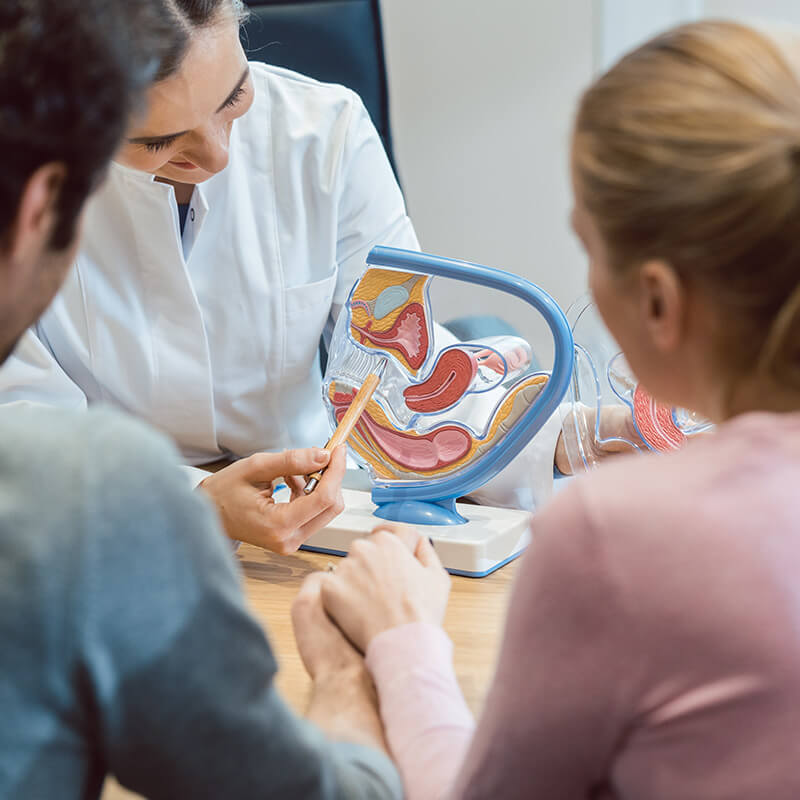
Based on your initial fertility evaluation, your doctor may recommend a hysteroscopy and/or laparoscopy to check for potential physical roadblocks to fertility.
While certain blood and urine tests can uncover many fertility issues, there is no substitute for looking directly at your internal reproductive organs to make sure they’re functioning properly.
Both laparoscopy and hysteroscopy can be used in diagnostic (looking only) and operative (looking and treating) forms.
What is laparoscopy?
Diagnostic laparoscopy is a procedure done under general anesthesia that uses a small telescope placed through an incision in the navel to look at the outside of the uterus, fallopian tubes, ovaries, and internal pelvic area. If an abnormality is found during the procedure, operative laparoscopy can often correct it at the same time, eliminating the need for a separate surgery.
Diagnostic laparoscopy can help your doctor diagnose problems such as:
- Ovarian cysts
- Endometriosis
- Uterine fibroids
- Adhesions (scar tissue)
- Ectopic pregnancy
- Other structural abdnormalities
Your procedure may evolve into operative laparoscopy in order to:
- Treat adhesions (scar tissue)
- Open blocked tubes
- Remove ovarian cysts
- Treat ectopic pregnancies
- Destroy or remove endometriosis
- Remove fibroids on the uterus (in some cases)
- Remove diseased ovaries or damaged fallopian tubes
Laparoscopy Downtime
Laparoscopy is an outpatient surgery, so you will be able to leave the hospital the same day and return to your normal activities within a few days. Some tenderness in the naval area is normal, along with discomfort in the abdomen, chest, and shoulders due to the gas used to distend your abdomen. You may also experience mild side effects of anesthesia such as dizziness or nausea.
What is hysteroscopy?
Diagnostic hysteroscopy is a procedure performed in either your doctor’s office or an operating room to look inside the uterine cavity. The hysteroscope (a long, thin, lighted, telescope-like instrument) is inserted through the cervix and into the uterus. This procedure is especially useful to evaluate women with infertility, recurrent miscarriage, or abnormal uterine bleeding.
Diagnostic hysteroscopy can help your doctor diagnose:
- Fibroids protruding into the uterine cavity
- Scarring
- Polyps
- Congenital malformations
This procedure is also used prior to Embryo Transfer after an IVF cycle to confirm the uterus is favorable to receive the embryos and improve pregnancy rates.
As with laparoscopy, diagnostic hysteroscopy can turn into operative hysteroscopy if an abnormality is found, correcting it at the same time in order to avoid additional surgery.
Operative hysteroscopy uses narrow tools inserted through a channel in the hysteroscope to:
- Remove fibroids
- Remove scar tissue
- Remove polyps
- Correct some structural abnormalities such as a uterine septum

Hysteroscopy Recovery
Since hysteroscopy is an outpatient procedure with no skin incisions, you should be able to return to your normal activities in 1-2 days. However, you may experience some vaginal discharge, cramping, and/or bleeding for several days after the procedure. In addition, your doctor may prescribe antibiotics and/or estrogen to prevent infection and help the healing process.
Complications are rare, but hemorrhaging, cervical lacerations, and uterine perforation are possible. Your doctor will discuss these risks with you further during your consultation.
Take steps to restore your fertility
Laparoscopy and/or hysteroscopy may be the treatment you need to restore your fertility and help you realize your dream of parenthood. Dr. Stephan Krotz and his team have the knowledge and tools to correct these and other fertility issues. Give us a call today at 713-401-9000 to schedule your fertility evaluation.
